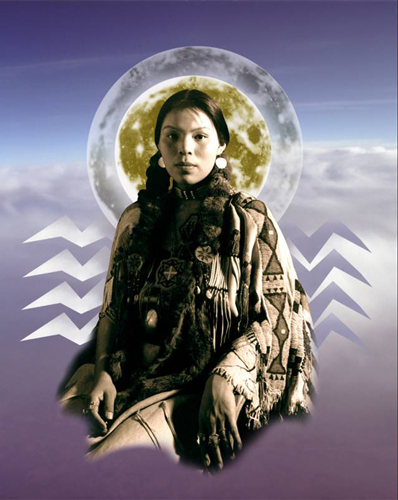Professor Hulleah J. Tsinhnahjinnie’s work in the MoMA, at UC Davis and at the C. N. Gorman Museum fosters Native American representation in art and academia
By ANVI KALUCHA — features@theaggie.org
Walking through the Museum of Modern Art in New York City during the past few months, you would have seen a familiar name on a picture titled “Vanna Brown, Azteca Style.” The black-and-white photograph features an Aztec woman in a traditional headdress, framed by a vintage, animated television border.
This artwork was created by UC Davis Native American Studies professor Hulleah J. Tsinhnahjinnie, who has been photographing and reinventing Native American portraits for many years. “Vanna Brown, Azteca Style” was part of the installation “Our Selves: Photographs by Women Artists from Helen Kornblum” from April 16 to Oct. 10 and can now be viewed online on the MoMA’s website.
Tsinhnahjinnie has been involved in the creative arts since she was a child; her father and his friends were artists, exposing her to painting and photography early on. She created her first pieces very young under the guidance of her father and has continued since.
Tsinhnahjinnie said she has been at the forefront of documenting many pinnacle moments for the Native American community in California, including, notably, the removal of the Pioneer Monument from the Civic Center in San Francisco. The statue depicted a colonizer and missionary standing over a nearly naked Native American man, serving as a graphic reminder of the years of abuse Indigenous people have faced in California.
“Once the statue was removed, on the plinth that it stood, community members from the San Francisco Native community posed, and I took portraits of them,” Tsinhnahjinnie said. “It was a reclamation of space and having something really racist finally taken away.”
Tsinhnahjinnie has worked with many women in the Indigenous community throughout her photography career, including in her collection of posters titled “Women of Hope,” which features influential Native American women leaders including poet Joy Harjo and surgeon Dr. Lori Arviso Alvord.
Tsinhnahjinnie’s work has spread far beyond the Davis community to inspire many individuals around the world, according to Kimberly Johnson, a Ph.D. student in the Department of Native American Studies.
“I was at Indigenous People’s Day in LA,” Johnson said, “and I started talking to this person, and he was like, ‘Oh, you’re a Ph.D. student at UC Davis? […] you work with the most famous, wonderful Hulleah Tsinhnahjinnie.’ And I said, ‘Yeah.’ And then he was like, ‘Oh, my god, they’re amazing.’ And he was from France. So it was like, people in France knew of her work.”
Johnson has known Tsinhnahjinnie since she took her Visual Sovereignty class (NAS 233) last fall, during which Johnson was exposed to a new perspective on the subject. Tsinhnahjinnie’s teaching style and patience in the course inspired Johnson to continue learning more, and they have worked together for over a year.
“Because I’m an older student, I didn’t really have these types of images or these people that I knew that looked like me that were able to do such impactful work,” Johnson said. “And, so now that I’m a graduate student, I don’t care how old I am, but it’s impactful. It’s like, she could do it, I could do it, and I love sharing who she is with my family and my community.”
Tsinhnahjinnie brought her passion for art to UC Davis and has continued to spread it with thousands of students. She is also the current director of the C. N. Gorman Museum, located in Hart Hall, which is currently closed for renovation.
Michelle Villegas-Frazier, the director of the Native American Academic Student Success Center (or Native Nest), said that Tsinhnahjinnie’s work is uplifting Indigenous communities in Davis.
“I believe Davis is the only [UC] that has a Native American museum on its campus,” Villegas-Frazier said. “And so with her leadership, […] with the work that she did at the MoMA and all the work that she’s doing now, it’s amplifying Davis as a community that’s supportive of its Native community. I think it’s also giving power and voice to a community that may never have had it before. It’s just really providing amplification of Native folks and Native communities.”
Tsinhnahjinnie is actively working on expanding the C. N. Gorman Museum to double its previous size, and it will feature more Indigenous artwork by students and faculty, upon reopening. She hopes that her pieces depict a sense of community and inspire a new generation of artists at UC Davis.
“When one looks at being an artist from a holistic, Indigenous type of beautiful […] you don’t just focus on yourself, which is more Western, but you really include community, and community is paramount, and that’s who you’re doing your work for,” Tsinhnahjinnie said.
Written by: Anvi Kalucha — features@theaggie.org




